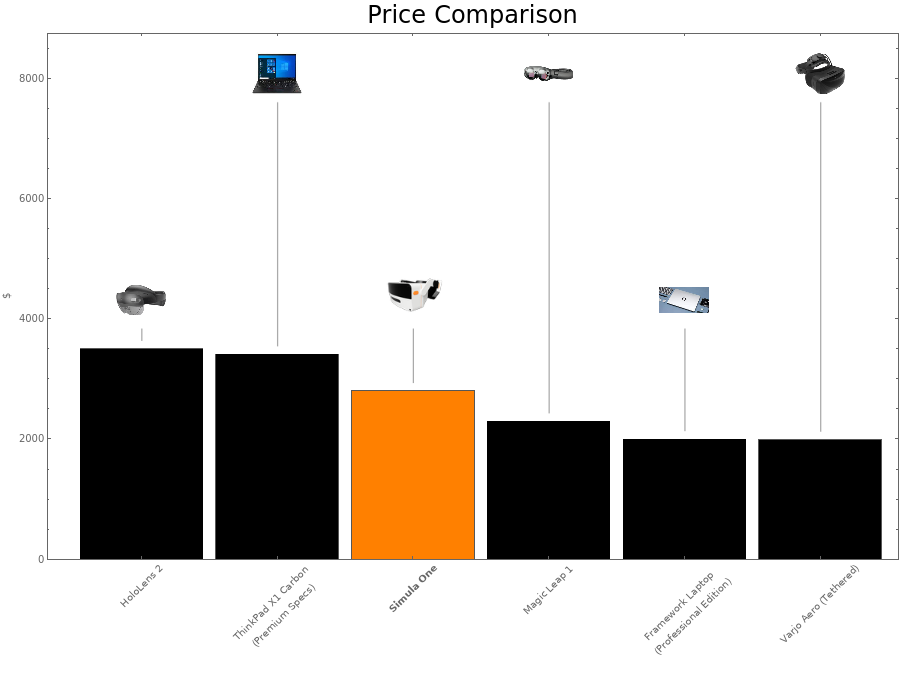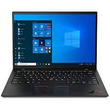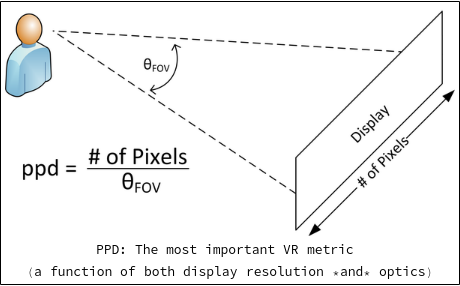1 What is the Simula One?
The Simula One headset is a VRC ("VR Computer"). To us, VRCs are a new category of computing device (alongside PCs & laptops) which allow people to get stuff done.

Since we are attempting to create a new product category (the "VR Computer"), it can be hard to situate it against other products fairly. There aren't, as far as we know, any other VR Computers available in the market right now (even Windows VR Computers), though there are some standalone AR headsets (HoloLens) which might fairly be called "AR Computers", and of course there are many premium laptops and gaming headsets too. Until VRCs become more prevalent, we think we should be compared against all of these different things (gaming headsets, premium laptops, and standalone AR devices) when consumers evaluate our price.
2 Why is the Simula One so expensive?
First, let's be honest: the Simula One is an expensive, early adopter product. From our perspective, it has been really hard to get a hardware product off the ground with a small team, zero economies of scale, and no interested institutional backers. We decided early on that, given the cards we were dealt, it's better to build a premium headset with a high price than to build a low-quality headset with a low price. This is because lower-end VR technology (e.g. the Quest 2) is simply not good enough for someone wanting to work several hours per day in a VR Computer instead of their laptop -- even if most people don't realize this yet. So our plan has been to charge a high/breakeven price for our first headset iteration, then lower it during future iterations as we build a better operation.
With all that said, the Simula One, as priced today, is still reasonably competitive against other premium office laptops and ultra-premium (high PPD) VR/AR gaming headsets. Roughly speaking, we're offering a headset as good as the tethered Varjo Aero (priced at $2K), with a premium-spec computer as good as a top-shelf Lenovo X1 Carbon bolted on as well (making up for the remaining $799 in price).
Of course, working in VR is better than working on a traditional laptop (like an X1 Carbon) because it provides unlimited screens and better work immersion. But we won't lie and say there are zero tradeoffs in choosing the Simula One over more traditional options (e.g., long lead times and lower battery life due to the resource-intensive nature of VR). Below, we make these tradeoffs as clear as possible, so you can make an informed choice about whether working in a VRC is right for you at this stage in its S-curve.

3 Simula One vs. Premium Laptops
While the Simula One can be used as premium gaming VR device in tethered mode, it is primarily designed to replace laptops & PCs with a completely different computing experience. So here is how our VRC compares with some other premium laptops in specs and price:
| Simula One | ThinkPad X1 Carbon Gen 9 Intel (14") | Framework Laptop (Professional Edition) | |
 |  |  | |
| Price | $2,799 Preorder Price; $3,500 MSRP | $3,409 MSRP | $1,999 MSRP |
| Manufacturer | SimulaVR | Lenovo | Framework |
| Platform |  |  |  |
| Linux | Windows 10 Pro (default OS) | Windows 10 Pro (default OS) | |
| Type of Headset | VR Computer (VRC) | Laptop Computer | Laptop Computer |
| PPD | 35.5 [1] | N/A | N/A |
| Resolution | 2448x2448 per eye | 1920 x 1200 14" single screen | 2256x1504 13.5" single screen |
| Refresh Rate | 90 hz | 60 Hz | 60 Hz |
| Speakers | ✗ | ✓ | ✓ |
| Microphone | ✗ | ✓ | ✓ |
| 3.5mm Audio Jack | ✓ | ✓ | ✓ |
| Ports | 1 USB4/Thunderbolt 4; 3-4 USB3.2 Gen 2 via USB-C with DisplayPort alt mode | Thunderbolt™ 4 power input; Thunderbolt 4; USB-A 3.2 Gen 1 x 2 | Customizable (USB-C / USB-A) |
| Video Connection | DisplayPort 1.4a, USB 3 | HDMI | Customizable (HDMI / DisplayPort) |
| WiFi | Wi-Fi 6 | Wi-Fi 6 | WiFi 6 with vPro |
| Bluetooth | Bluetooth 5.2 | Bluetooth 5.2 | Bluetooth 5.2 |
| Chipset | Integrated | Integrated | Integrated |
| CPU | i7-1165G7 Processor (EDIT: We are now providing i7-1165U Processor (12th Gen)) | i7-1165G7 Processor | Intel® Core™ i7-1185G7 |
| GPU | Iris Xe graphics | Intel Iris Xe Graphics | Intel Iris Xe Graphics |
| Memory | 16 GB | 16 GB | 32 GB |
| Storage | 1 TB | 1 TB | 1 TB |
| SD Card Slot | TBD | ✗ | Customizable (Micro SD) |
| Battery Life | TBD (EST: 3-4 hours) | 15 hours | 10-11 hours |
4 Simula One vs. Gaming VR Headsets
Simula's headset itself is also very premium: the combination of our high-resolution displays and sophisticated optics provide a higher PPD experience than any other portable VR headset on the market. We emphasize this because PPD is the most important metric when evaluating a VR Computer (even more important than raw display resolution!), since it ultimately determines how crisp text and other fine details will appear. We could have easily cut headset costs by sacrificing on PPD, but we decided it was too important to VR Computing adoption to half-ass on, so we leaned towards a premium experience.

With that in mind, here is how the Simula One compares to other VR gaming headsets in the market:
| Simula One | Varjo Aero (Tethered) | Valve Index (Tethered) | Oculus Quest 2 | |
 |  |  |  | |
| Price | $1,999 Tethered-Only Price; $2,799 Full Price (Preorder) | $1,990 | $1,000 | $299 ($799 w/o Facebook login) |
| Platform |  |  |  |  |
| Linux | Varjo / SteamVR | SteamVR | Oculus Home, SteamVR (Facebook account required) | |
| Type of Headset | VR Computer (VRC) | Tethered Gaming/Entertainment Device | Tethered Gaming/Entertainment Device | Gaming/Entertainment Device |
| PPD | 35.5 | 35 | 11.07 | 20.58 |
| Resolution | 2448x2448 per eye | 2880x2720 per eye | 1440x1600 per eye | 1832x1920 per eye |
| Refresh Rate | 90 hz | 90 Hz | 144 Hz | 120 Hz |
| Field of View | 100° horizontal; 100° vertical | 115° horizontal; | 107° horizontal; 104° vertical | 89° horizontal; 93° vertical |
| Passthrough Cameras | Dual wide-angle high-resolution RGB cameras | N/A | Dual 960x960 passthrough cameras | Grayscale via tracking cameras |
| IPD Range | 55mm-77mm hardware adjustable (automatic as stretch goal) | 57-73 mm hardware adjustable (automatic) | 58-70 mm hardware adjustable | 58-68 mm (hardware adjustable); 3 fixed IPD settings: 58mm, 63mm, 68mm |
5 Simula One vs. Standalone AR Headsets
As mentioned above: there are no other VR Computers (even Windows VR Computers!) to compare the Simula One to, but there are some comparable AR headsets out there that we can compare ourselves to. Here is how we stack up:
| Simula One | HoloLens 2 | Magic Leap 1 | |
 |  |  | |
| Price | $2,799 Preorder Price; $3,500 MSRP | $3,500 | $2,295 |
| Platform |  |  |  |
| Linux | Windows Mixed Reality | LumenOS (Android Based) | |
| Type of Headset | VR Computer (VRC) | AR Computer | Originally Gaming/Entertainment; now has "Enterprise Solutions" |
| Resolution | 2448x2448 per eye | 1440x936 per eye | 1280x960 per eye |
| PPD | 35.5 [2] | 20 PPD (measured) [3] | 30 |
| Refresh Rate | 90 hz | 60 Hz | 122 Hz |
| Field of View | 100° | 43° horizontal; 29° vertical; 52° diagonal | 40° horizonal; 30° vertical; 50° diagonal |
| Passthrough | Dual wide-angle high-resolution RGB cameras | Native passthrough, IMP camera @ 30fps | Native passthrough, 1080p camera @ 30fps |
| Speakers | ✗ | Integrated stereo speakers | Integrated stereo speakers |
| Microphone | ✗ | ✓ | ✓ |
| 3.5mm Audio Jack | ✓ | ✗ | ✓ |
| Ports | 1 USB4/Thunderbolt 4; 3-4 USB3.2 Gen 2 via USB-C with DisplayPort alt mode | USB Type-C | USB Type-C |
| Video Connection | DisplayPort 1.4a, USB 3 | ✗ | ✗ |
| WiFi | Wi-Fi 6 | WiFi 5 (802.11ac 2x2) | WiFi 5 802.11a/g/b/n/ac, dual-band |
| Bluetooth | Bluetooth 5.2 | Bluetooth 5.0 | Bluetooth 4.2 |
| Chipset | Integrated | Qualcomm Snapdragon 850 | |
| CPU | i7-1165G7 Processor (EDIT: We are now providing i7-1165U Processor (12th Gen)) | Octa-core Kryo 385 (4x 2.96 GHz, 4 x 1.8 GHz) | NVIDIA® Parker SOC CPU |
| GPU | Iris Xe graphics | Adreno 630 | NVIDIA Pascal™ |
| Memory | 16 GB | 4 GB | 8 GB |
| Storage | 1 TB | 64 GB | 128 GB |
| SD Card Slot | TBD | ✗ | ✗ |
| Battery Life | TBD (EST: 3-4 hours) | 3 hours | 3 hours |
[1] See https://kguttag.com/2020/07/08/hololens-2-display-evaluation-part-2-comparison-to-hololens-1/ for calculation of the Hololens' PPD.
